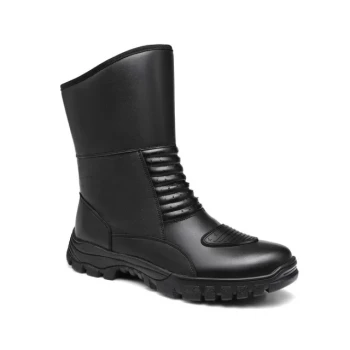In the harsh conditions of the Vietnam War, Australian soldiers overwhelmingly preferred American jungle boots because their own standard-issue footwear was a World War II-era design fundamentally unsuited for the environment. The American M-1966 jungle boot was a modern, purpose-built tool offering superior drainage, protection, and materials that directly countered the tropical realities of Vietnam.
The preference for American jungle boots was not about brand or origin; it was a matter of survival and operational effectiveness. The US boot was a specialized tool engineered for the jungle, while the Australian-issued boot was a general-purpose relic from a previous war.
The Problem with Standard-Issue Australian Footwear
The standard footwear issued to Australian troops at the beginning of the conflict was the "Tropical-Studded Ankle Boot," a design with roots in WWII.
A Design from a Bygone Era
This boot was a product of a different time and a different understanding of tropical warfare. Its construction and features were simply not engineered for the relentless wet heat and specific threats of the Vietnamese jungle.
The Critical Flaw of Water Retention
Older boot designs, often made primarily of leather, trap water. In a perpetually wet environment, this leads to constantly soaked feet, significantly increased boot weight, and severe medical issues like trench foot.
Inadequate for the Terrain
The "studded" sole was not optimized for the slick mud and dense undergrowth of the jungle, and the boot lacked specific protections against the unique dangers of the battlefield, such as booby traps.
Key Design Advantages of the American M-1966 Jungle Boot
The American jungle boot was the result of direct experience and iterative design focused squarely on solving the problems soldiers faced in Vietnam.
Engineered for a Wet Environment
The most significant innovation was the inclusion of screened drainage eyelets near the instep. These simple vents allowed water and mud that entered the boot to be actively squeezed out with every step, preventing the foot from remaining submerged.
Superior Material Science
The boot combined a leather toe and heel for durability and structure with a nylon/canvas upper. This hybrid approach made the boot lighter, more breathable, and far quicker to dry than an all-leather design.
Direct Threat Mitigation
A crucial feature was the integration of a stainless steel plate into the sole. This was a direct countermeasure to the Viet Cong's use of sharpened punji stake traps, a common and dangerous threat that could easily pierce a standard boot sole.
The Real-World Impact on the Soldier
This difference in equipment had a direct and significant impact on the daily life and effectiveness of the Australian soldier.
Preventing Debilitating Foot Conditions
By allowing feet to dry faster, the American boots drastically reduced the incidence of trench foot and other fungal infections. Healthy feet are essential for an infantry soldier's mobility and effectiveness.
Increased Comfort and Reduced Fatigue
A lighter, faster-drying boot is far more comfortable on long patrols. This reduction in physical burden and discomfort directly translates to less fatigue and higher morale.
Enhanced Confidence and Durability
Knowing your footwear is durable and protects you from specific, known threats allows a soldier to move with more confidence. The preference among elite Special Air Service (SAS) troopers, who valued comfort and durability above all, underscores the boot's superior performance.
Core Lessons in Military Equipment Design
The story of these boots provides timeless insights into the philosophy of designing effective military gear.
- If your primary focus is soldier effectiveness: You must design equipment for the specific environment of the conflict, not rely on general-purpose or outdated gear.
- If your primary focus is troop health and morale: Prioritize features that mitigate the most common environmental hazards, such as water drainage and specific threat protection.
- If your primary focus is long-term success: Invest in modern materials and iterative design that directly address the realities faced by personnel in the field.
The choice between these two boots highlights a critical principle: the right gear is not an accessory, but a fundamental component of survival and success.
Summary Table:
| Feature | Australian WWII Boot | American M-1966 Jungle Boot |
|---|---|---|
| Drainage | Trapped water, caused trench foot | Screened eyelets for active water expulsion |
| Sole Protection | Standard rubber studs | Integrated stainless steel plate vs. punji stakes |
| Material | Heavy, slow-drying leather | Lightweight nylon/canvas & leather hybrid |
| Terrain Suitability | Slippery on mud, general-purpose | Optimized for jungle undergrowth and wet conditions |
Need Purpose-Built Footwear for Demanding Environments?
As a large-scale manufacturer, 3515 produces a comprehensive range of durable, high-performance footwear for distributors, brand owners, and bulk clients. Our production capabilities encompass all types of specialized shoes and boots engineered for specific conditions—ensuring comfort, protection, and reliability.
Let us help you equip your team with the right gear for success. Contact us today to discuss your custom footwear requirements.
Related Products
- Wholesale Tactical Boots High-Traction & Reflective for Bulk & Brand Orders
- Durable Military Combat Boots with Water Drainage for Wholesale & OEM
- Wholesale Waterproof Tactical Boots Custom Suede & High-Traction Soles
- Durable Leather Tactical Boots Wholesale & Custom Manufacturing for Brands
- Durable Leather High-Ankle Tactical Boots for Wholesale & Custom Manufacturing
People Also Ask
- What features distinguish a tactical boot from regular boots? Uncover the Key Design Differences
- Why is strong ankle support important in tactical boots? Prevent Injury & Boost Performance
- How does the material of tactical boots affect their performance? Choose the Right Material for Your Mission
- How does breathability contribute to the comfort of tactical boots? Prevent Blisters and Boost Performance
- What are the primary uses of tactical boots? Essential Footwear for Demanding Professionals



















